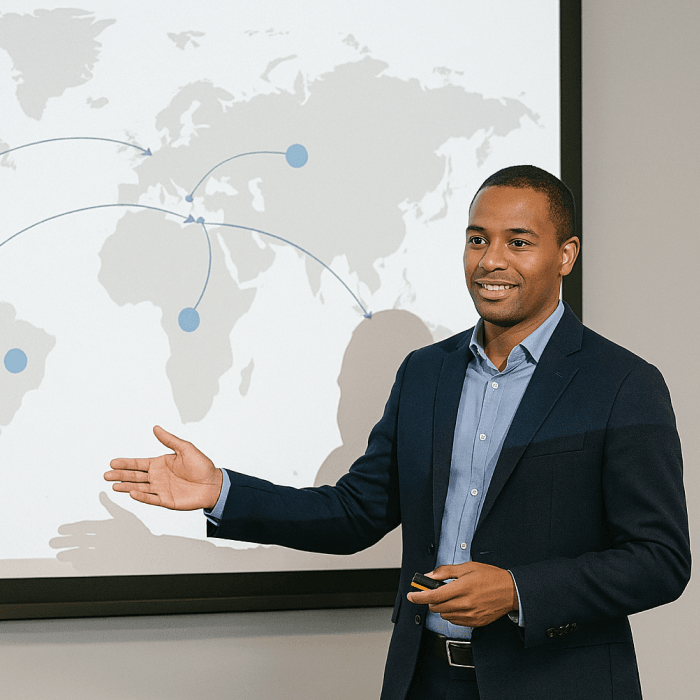Updated: January 24, 2024- 14 min read
Editor's note: the views expressed in the following post belong to the author.
When you think of your dream Product Management job, what would it be? Some might envision a particular domain or problem space they’re passionate about. Others might picture an ideal organization size, receiving mentorship from seasoned Product Leaders, or taking on a specific Product role, such as a technical Product Manager or growth Product Manager.
For me, it’s always been building products and programs that aim to make some difference in the world – whether that’s providing Medicare patients with high-quality care, making hiring more equitable, or cultivating the next generation of Product Managers who want to work in social impact.
It wasn’t surprising to me that PMing solutions like the above, in environments ranging from government to the private sector and now philanthropy, would be a fulfilling experience. It’s empowering to wake up every day and engage in work that attempts to move the needle on some of society’s most pressing challenges. However, from a Product perspective, I’ve observed some surprising nuances. Though you might go through the same phases of the product development lifecycle – product discovery, planning, development, and so on – these phases require a slightly different approach in a social impact context.
Here are four key nuances I’ve observed about Product Management in social impact:
Product metrics alone aren’t sufficient in demonstrating societal impact.
Competitive analysis is driven by need as opposed to revenue.
Your target user isn’t necessarily a “superuser,” but rather an overlooked one.
Designing products with as opposed to for users is critical.
1. Product metrics alone aren’t sufficient in demonstrating societal impact.
Working as a Product Manager in a mission-driven organization, or as a “social sector PM,” challenges you to truly get to the root of how you measure success. In Product Management, we often talk about how to go beyond vanity metrics, such as number of registered users or number of downloads, that look good on the surface but aren’t an accurate depiction of if your product is performing well or advancing organizational goals. To avoid this common pitfall, we tease out these metrics further to make them more actionable, optimizing instead for metrics like daily active users (DAUs) or customer retention rates to tell a more nuanced and representative story. However, in a mission-driven organization, it doesn’t stop there.
At the end of the day, a mission-driven organization’s bottom line isn’t revenue or another easily quantifiable metric, but rather, the impact it has on the world. As a result, metrics are rooted in the effect a product has on those being served. For example, a key metric for the healthcare non-profit CareMessage is the number of cancer screenings for low-income individuals. For humanitarian aid startup Hala Systems, it’s the number of credible, real-time airstrike warnings issued to civilians in conflict zones. However, even metrics like these have their limitations.
As a result, social sector PMs need to take impact metrics a step further by determining whether a product actually led to real-world outcomes. For example, did more cancer screenings ultimately lead to better health outcomes for low-income individuals? Did more accurate and timely airstrike warnings result in fewer civilian deaths? To put it simply, in order to determine whether a product actually furthers impact, social sector PMs must have a strong understanding of how individual impact metrics fit into the bigger picture. One way to do this is through investing ample time in developing a product strategy and more specifically through crafting a product mission statement upfront.
After defining your strategy is the followthrough, or actually tracking progress against your impact metrics. It can seem like a difficult and intimidating task to prove out whether a product ultimately achieves some form of social change or societal impact. The truth is, it can be quite challenging and take a lot of resources (staff, money), research (randomized control trials, other studies) and time (years, even decades) to prove out. After all, lofty outcomes like improved health or safety do not happen overnight, and can be influenced by multiple factors.

Source: Fresh Spectrum Information Design
A good first step can be coming up with a research plan outlining additional data that will help you prove out your product’s impact, as well as methods and dependencies for collecting this data. For example, at my previous startup Pymetrics, our team conducted studies with numerous clients to determine whether our candidate assessment product ultimately led to more equitable and higher-quality hiring. To complete these studies, we relied on clients to provide us with data on the diversity, performance, and retention of candidates.
The next step is thinking about other levers that, in parallel with product development, can lead to broader societal impact. For example, Pymetrics open-sourced a tool that detects bias in algorithms. Pymetrics also engaged the NYC government on passing legislation that reduces bias in hiring through requiring hiring AI tools to be audited.
2. Competitive analysis is driven by need as opposed to revenue.
Before jumping into product development, Product Managers carve out time to conduct market and competitive research, investigating questions like: what new market trends are on the horizon? Who are key players in this market, and what are their value propositions? What gaps exist in the current solutions provided? This certainly remains true for social sector PMs. However, these Product Managers think about market dynamics, particularly competition, through a slightly different lens.
It’s important to identify competitors and what sets them apart in their market. At the end of the day, mission-driven organizations are still competing for funding and clients. Additionally, though impact is prioritized over revenue as a North Star, revenue is what ultimately will enable these organizations to be self-sustaining and scale their impact. However, the intent of understanding the competitive landscape and how to uniquely position your organization in a market is not to take market share from others – especially from others that are also trying to do good. Our world has way too many messy problems to solve, and it can use all the help we can.
Rather, a key motivator behind social sector PMs conducting competitive analysis is to understand how they can provide a less costly, more accessible alternative that caters to underserved users. For example, as featured by TechCrunch, tech nonprofit Ameelio observed that the prison communication market was dominated by for-profit companies charging inmates as much as a dollar per minute to call their loved ones, using platforms that haven’t been updated in years. Recognizing this market failure and the need to shift burden away from inmates – especially with videoconferencing these days being nominal or no charge – Ameelio built a free messaging and video calling platform for inmates that integrates with modern software like Twilio to provide a seamless user experience.
Another motivator is to understand how your organization might complement other players in the market to provide a more holistic solution. For example, tech nonprofit Freeworld shares with Ameelio the goal of uplifting incarcerated individuals and ultimately reducing recidivism. As Ameelio expands its offerings to provide post-release support, it might collaborate with Freeworld to train and place incarcerated individuals in high-demand roles like trucking.
3. Your target user isn’t necessarily a “superuser,” but rather an overlooked one.
It’s critical for Product Managers to determine what user base they’ll be targeting. Usually, Product Managers will optimize for the highest engagement users. However, you’ll see in many cases social sector PMs intentionally prioritizing lower engagement users, particularly because they’ve been historically overlooked – be it because they’re harder to reach geographically or have less resources (i.e. money, time or social capital). Whereas other Product Managers might target engagement hotspots, social sector PMs capitalize on engagement blindspots. This isn’t to say that high-engagement isn’t important, as it’s key to a product’s adoption. This also doesn’t mean that low-engagement users can’t eventually be converted into high-engagement users, as overlooked individuals too can demonstrate this potential if given the opportunity. However, Product Managers in mission-driven organizations will often prioritize need, and ultimately equity, over quantity or initial ease of access.

A simplified representation of who Product Managers can decide to serve, with a focus on key factors such as need and reach.
Source: Fast Forward Tech Nonprofit Playbook
Additionally, it’s interesting to note that some mission-driven organizations have a “built-in” user base. In other words, users have no choice but to interface with these organizations because they are the ultimate provider of a specific service or benefit. This idea is particularly prevalent in services provided by the U.S. federal government. For example, in order to apply for services like natural disaster assistance, U.S. citizenship, small business loans, and veterans’ benefits, every American (or third-party organization that supports them) will have to interact with a government tool or website. Built-in users may sound like an ideal set-up on the surface. However, power, as they say, comes with responsibility – and in a Product context, a lot of efforts to build trust with users, especially when delivering life-dependent services. President Biden’s 2021 Executive Order on transforming federal customer experience (CX) and service delivery sums up this responsibility well: “When a disaster survivor, single parent, immigrant, small business owner, or veteran waits months for the Government to process benefits to which they are entitled, that lost time is a significant cost not only for that individual, but in the aggregate, for our Nation as a whole.”
4. Designing products with as opposed to for users is critical.
A core competency for Product Managers is user-centricity, or the ability to keep users front of mind when building products. You’ll see that a focus on users is incorporated in many company value systems. Take Amazon as an example, who’s first leadership principle is customer obsession. Or Notion, who’s principle of truth-seeking is underscored by always starting with their users. Many organizations agree that centering their users is not only the right thing to do, but also the smart thing to do – resulting in greater customer satisfaction and retention, and even revenue. According to a report by Deloitte, “client-centric companies are 60% more profitable compared to companies not focused on the customer.”
Although all great Product Managers recognize the importance of user-centricity, oftentimes this concept shows up in very targeted parts of the product development process. For example, a common point in which we interact with users is upfront during the research phase. After coming up with a hypothesis and doing some market research, Product Managers will set up conversations with users to understand their pain points, needs and desires, and how they might translate into potential solutions. Another common point in which users are engaged is post-prototype creation or during the testing phase. At this point, users are providing feedback on a solution that an organization is proposing or has already developed. Based on this user feedback, the Product Manager will further iterate on the solution or prepare it for launch.
I’ve witnessed many social sector PMs demonstrate the superpower of not just including users on the front and tail-end of the product development process, but rather incorporating them throughout the process, particularly during the design phase. This concept is referred to as co-design, which is defined by Stratos Innovation Group as “the act of creating with stakeholders (business or customers) specifically within the design development process to ensure the results meet their needs and are usable.” Co-design drives home the point that organizations should be building with – as opposed to for – their users to make solutions truly representative of community needs and desires. Take housing justice nonprofit JustFix as an example, which directly engaged individuals fighting wrongful convictions through journey mapping and design workshops to launch a Letter of Complaint tool. Or foster care nonprofit Think of Us, which recently launched a Center for Lived Experience dedicated to specifically engaging people with lived experience in product design, policy making, and other initiatives aimed at re-architecting the child welfare system.
Mission-driven organizations like JustFix and Think of Us put their end-users front and center, though they also make a concerted effort to engage other critical stakeholders, such as community organizations and policy makers, in the design process. So much so specifically with policy makers, that a concept has emerged called user-centered policy, which is described by the Beeck Center as “policy that is intentionally designed and implemented with the end user as a co-designer.”
For example, the U.S. Digital Service (USDS), a civic tech startup headquartered at The White House, adopted user-centered policy when partnering with the Center for Medicare and Medicaid Services (CMS) to improve how the healthcare agency collects feedback from doctors on changes to Medicare. As Natalie Kates (Product Lead, U.S. Digital Service) explains in her piece Injecting Human-Centered Design into Government Policymaking, proposed Medicare policy changes are communicated to the public through lengthy, jargon-filled PDFs that can be 2000+ pages long. To improve this feedback process, USDS and CMS brought together a team of 200 individuals, ranging from software engineers to policy makers, to align on a user-centered goal and brainstorm potential solutions. These efforts most notably resulted in the Federal Register, the official journal of the U.S. government, linking out to a website that included designs to help the public visualize proposed Medicare policy changes.

A design example helping the public visualize how proposed legislation would impact the user experience for submitting Medicare data. Source: Quality Payment Program (QPP)
One can argue that embedding users and other stakeholders throughout the product development process is more time-consuming, as practices like co-design and user-centered policy making require coordination and alignment across numerous stakeholders. However, the long-term benefits ultimately outweigh this short-term sacrifice. Product Leader and JustFix co-founder Georges Clement says, “The counter would be that you build the right product sooner, so you save time in the long run because you don't have to pivot so many times. The first product is in theory closer to a problem-solution fit, due to the proximity with users from the early stages of research and development.” He also notes that co-creation helps build trust with users – particularly with vulnerable populations, which is harder to do – by getting more people excited about launch and distribution. The stakeholders and users involved in the product development process, in turn, then serve as strong advocates when you get the product into users’ hands.
Societal problems that mission-driven organizations seek to address are complex and multifaceted, and therefore can’t just be solved by one single product or discipline. Giving users and stakeholders the pen, both figuratively and literally, can not only help with building trust and user adoption, but can also tackle the problem from many more angles and therefore lead to deeper, more systemic impact.
Ready to take the leap into social impact?
I’d encourage every Product Manager to do a stint in a mission-driven organization. The obvious reason is that they’d be leveraging their talents towards making a real difference in our world. Though another key reason, as described in this piece, is that Product Management looks different in an impact context. And because of this, it presents a compelling learning opportunity, exposing Product Managers to new experiences and realities that enable them to develop skills and perspectives they might not have otherwise.
If you’re interested in learning more about Product and other tech roles in social impact, check out Tech Jobs for Good, All Tech Is Human, and Fast Forward, which aggregate relevant opportunities in the space via job boards and newsletters. If you’re looking to first get your feet wet, consider organizations like the U.S. Digital Service, U.S. Digital Response, and Rippleworks, which offer part-time, advisory, fellowship, and other time-boxed opportunities in social impact.
In the meantime, you don’t necessarily need to work in social impact in order to practice skills such as refining and contextualizing your metrics, viewing your competitive landscape from different angles, and further integrating users into the product development process. Everyone can take a page from the social sector PM’s playbook.
About the Author
Joni is a Product Leader who is passionate about building products and programs for social good. She is currently a Senior Manager on the Technology & Impact team at Schmidt Futures. Joni previously served in Product and strategy roles at Pymetrics and at the U.S. Digital Service in The White House.
Updated: January 24, 2024





